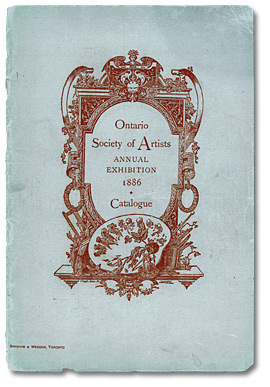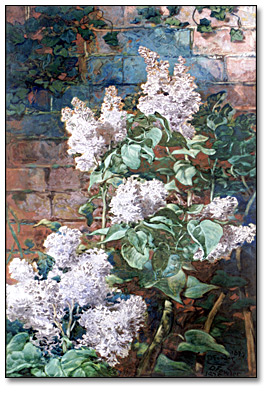
Table of Contents
The Founding of the Society and its First Exhibition
Early Purchases and the Foundation of Art Education
The Ballot Pictures and the Provincial Art Gallery | The Final Purchases
|
By 1874 membership in the Society had risen to 40 artists, engravers and architects. The exhibition for that year was held in June at the Music Hall on Toronto’s Church Street. Although the provincial government would continue to give the Society a $500 grant towards the Art Union over the next few years, the records of which artworks might have been purchased are inconsistent. How and by whom the works were chosen, especially in the early years, is also not clear. In the lead-up to the1875 annual exhibition, the Minutes of the Society’s regular February meeting reveal consideration of the issue:
|
|||||||||||||||||||
|
Whatever the final arrangement entailed, at least two watercolours are known to
have been acquired by the government from the Society’s 3rd annual exhibition:
Summer has Come Again by Daniel Fowler and Lords of the Forest
by Lucius R. O’Brien. |
|||||||||||||||||||
|
|
|
||||||||||||||||||
|
In addition to the annual search for a suitable space for the exhibition, the Society continued to be concerned with the lack of art education in the province. Schools like the Mechanics Institute could provide basic classes in technical subjects, while art instruction tended to be limited to private lessons in the homes or studios of the city’s more established artists. Following deputations from the Society to lobby then Minister of Education, the Honourable Adam Crooks, a grant of $1,000 was made available in1876. The grant allowed the renovation of leased premises at 14 King Street West big enough to be used as both art school classrooms and gallery space. Long-time secretary of the Society, R. F. Gagen would later comment about the first exhibition held there:
|
|
||||||||||||||||||
|
The government purchased Daniel Fowler’s Water Mill, Berncastle on the Moselle from this exhibition. It is also quite possible that a watercolour by George Harlow White, now in the collection, and listed in the OSA catalogue for 1876 was acquired at the same time.
|
|
||||||||||||||||||
|
On October 30, 1876 the modest classrooms were opened as the Ontario School of Art with 25 students enrolled. The instructors were drawn from the OSA membership and included Lucius O’Brien, Charlotte Schreiber, John A. Fraser, R. Baigent, Henri Perré, and Marmaduke Matthews. Thomas Mower Martin was appointed the school’s first Director. Daytime and evening classes were offered for which the teachers were paid $4 per lesson. While the school would continue to grow, its financial situation remained tenuous. The Society relied on continuous lobbying efforts in order to secure a commitment of long-term funding from the provincial government. |
|||||||||||||||||||

|
While the Society was pressing for the establishment of a publicly-funded permanent art school, it continued to hold its annual exhibitions. In 1877 it once again used the facilities offered by its King Street gallery. Although no records detail the government purchases for this year, a grant in aid of the Art Union for $500 was made in addition to the $1,100 allocated for the art school. The OSA’s own accounts record $520 as being spent on paintings for the Ontario Collection. The only work listed in the exhibition catalogue and found in the collection today however, is George Harlow White’s, The Market Place, Quebec offered for sale at $25.
Click to see a larger image (221K) |
||||||||||||||||||

|
|||||||||||||||||||
|
The cost of the works as well as the method of selection for the government purchases
would vary over the ensuing years. As the price of the work tended to be equated
with quality, F. M. Bell Smith proposed at the June 16 meeting in 1876 that the
$500 government grant be used to purchase pictures valued at $100 each. |
|||||||||||||||||||
|
However, this motion was not carried and instead it was approved that no restriction be put on price but that works “shall be chosen first, and be of the best quality.” In order to make the selection based on these criteria, each exhibiting member was instructed to vote for works up to the amount of the grant. After review by the committee responsible for vetting the selections, the paintings with the highest number of votes would then be purchased on the government’s behalf.
Frederic Marlett Bell-Smith, R.C.A., [before 1924]
|
![Photo: Frederic Marlett Bell-Smith, [before 1924]](pics/7798_bell_smith_270.jpg)
|
||||||||||||||||||
|
The Society’s sixth annual exhibition was held in May of 1878 again at the Society’s Gallery on King Street West. Although the government provided the $500 grant to the Art Union, no records of any purchases have been located and none of the 218 works listed in the catalogue can be found in the collection today. |
|||||||||||||||||||
![Oil on canvas: A Quiet Afternoon, Beaupre, [n.d.]](pics/ac622064_spurrcutts_520.jpg)
Click to see a larger image (160K) |
|||||||||||||||||||
|
After 1878, the Society’s minutes often included a listing of the works purchased
from subsequent exhibitions. From the succeeding two exhibitions held in 1879 and
1880, the government purchased a total of 20 paintings valued at $930. However,
none of these works are still in the collection. One, The Newsboy
by Robert Harris, was later recorded as belonging to the
OSA’s own collection from which it was gifted to the Art Gallery
of Ontario in 1947.
|
|||||||||||||||||||
|
Although the government continued to give the Society the $500 grant, it is unclear if the money was allocated in its entirety to purchase works for the province or if a second collection belonging to the Society was also being formed.
Click to see a larger image (155K) |
 |
||||||||||||||||||
|
|
|||||||||||||||||||

|
|||||||||||||||||||
![Photo: Robert Harris, [before 1920]](pics/7812_r_harris_270.jpg) |
It is not known what direction was given by the government as to how the annual grant should be used and the society's minutes and annual reports often reveal a certain ambivalence towards it. According to Vice-President, Robert Harris’s Report for the year ending May 1, 1881, although in receipt of the $500 grant, the Society expended only $250 on the “Ontario Collection of Pictures Purchased.” At a meeting held on May 3, 1881 the Executive decided that the $500 grant would be better left in the bank for an indefinite period.
Robert Harris, C.M.G., R.C.A., [before 1920]
|
||||||||||||||||||
|
Between 1881 and 1895 the records make little mention of works purchased for the government and it’s possible there were none. This situation is not surprising given the frustration expressed by the Society over the lack of funding for the school of art.
Click to see a larger image (201K) |
 |
||||||||||||||||||
|
In 1882, a new arrangement between the OSA and the government resulted in the move of the school to rooms provided in the Normal School Building in St. James Square, site of present day Ryerson University. However, by 1884 relations between the Society and the government concerning this arrangement had become strained. The situation came to a head over what the Society felt to be unwarranted interference by Dr. S. P. May, the government's representative on the Art School's Governing Council. The exasperation of the Council’s position is revealed in the letter of resignation sent in February by Lucius O’Brien to the OSA’s vice president: |
|||||||||||||||||||
|
|||||||||||||||||||
|
Following O’Brien’s resignation, the
OSA
offered to sever its ties with the school. With the agreement of the province’s
new Minister of Education, George Ross, the Society’s involvement with the
provincial art school would lay dormant until 1890.
|
|||||||||||||||||||
|
This slideshow uses javascript.
If your browser does not support javascript, click here to view the html version of this OSA slideshow.
|
|||||||||||||||||||
|
This slideshow uses javascript.
If your browser does not support javascript, click here to view the html version of this OSA slideshow.
|
|||||||||||||||||||
|
|
|||||||||||||||||||
|
|||||||||||||||||||

|
|||||||||||||||||||


![Photo: Robert Ford Gagen in his studio, [ca. 1900]](pics/10391_ford_gagen_270.jpg)




